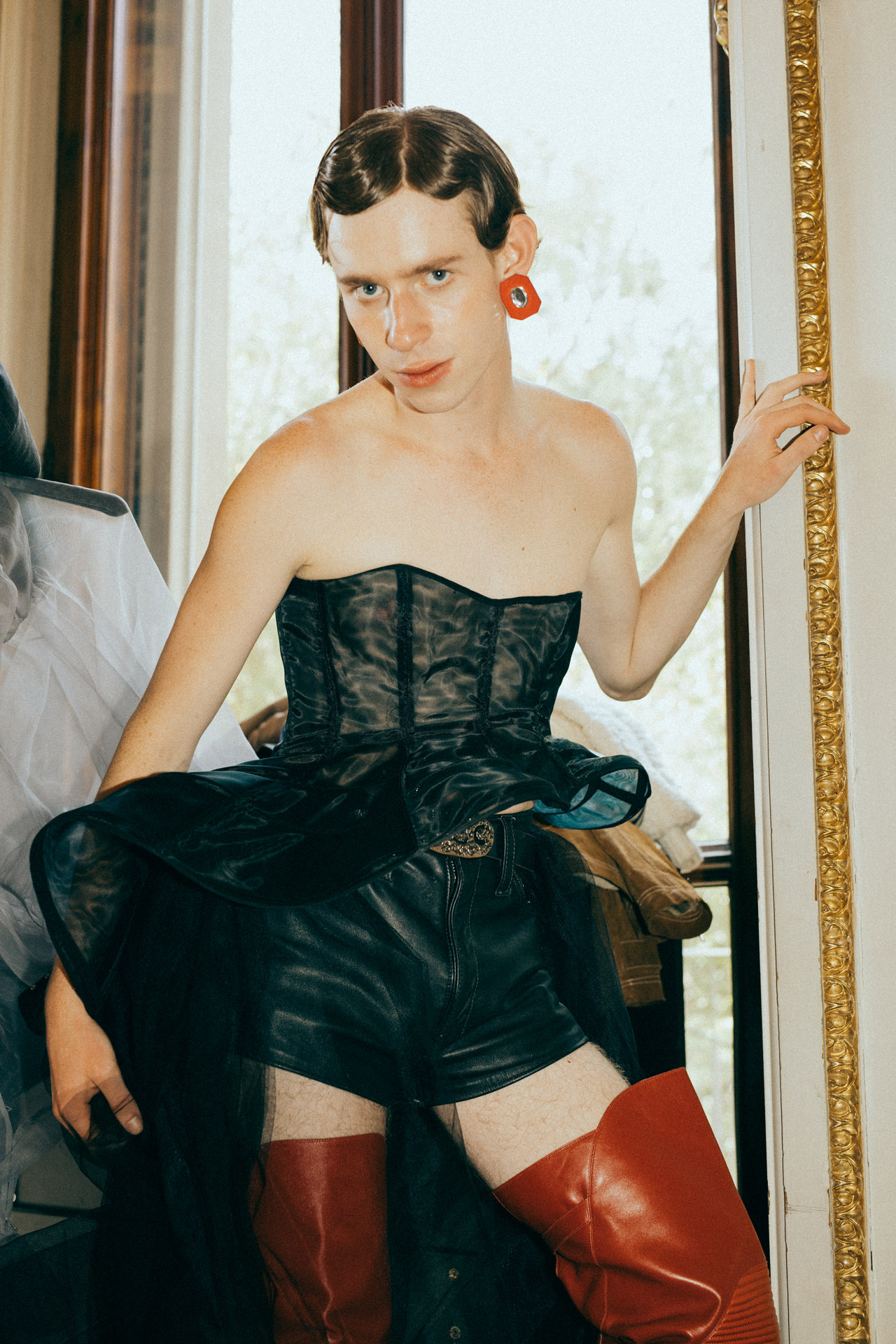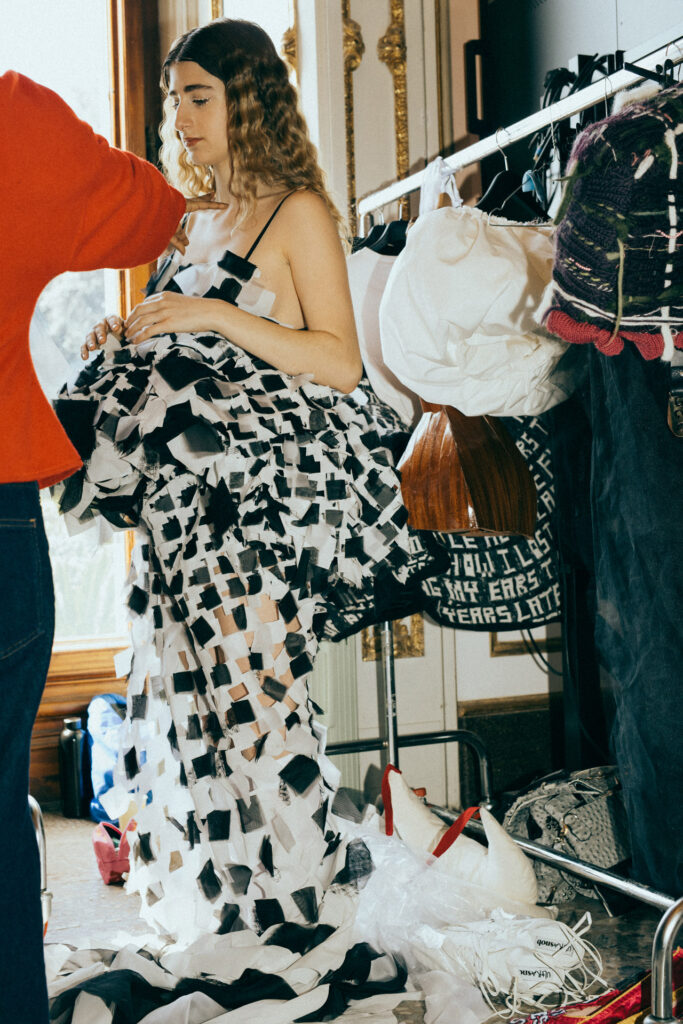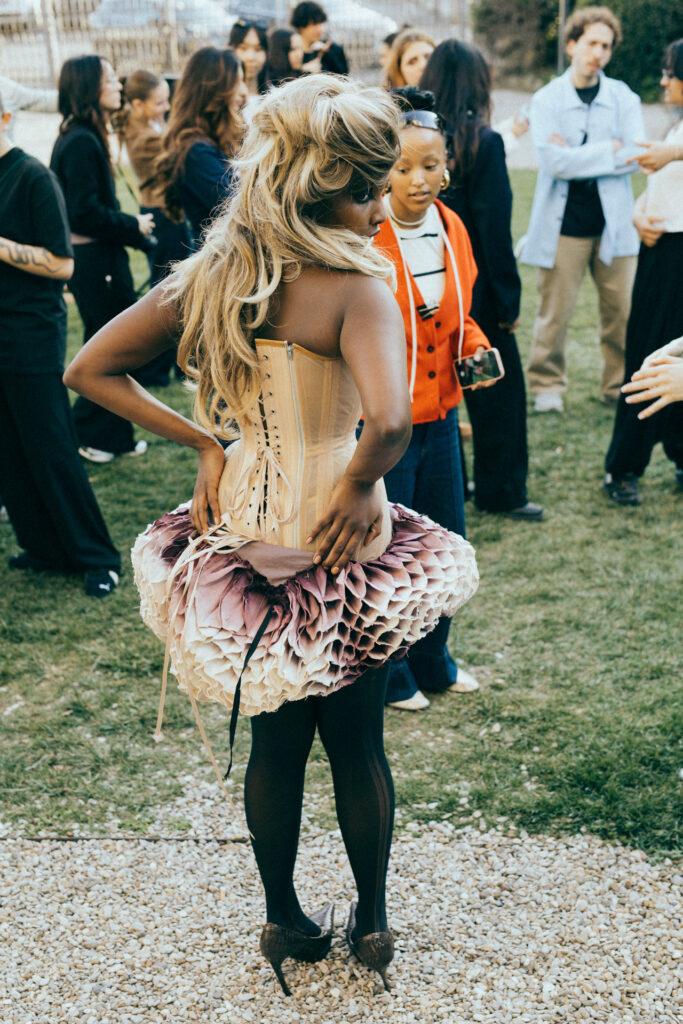Student, Maria Monteiro de Barros, on the advent of this year’s editorial collaboration between Polimoda’s Master in Fashion Art Direction and Vogue Italia, explores the future of queerness in fashion through the voices of the school’s LGBTQ+ students. Reflecting on themes of identity, expression, and inclusion, she examines how the next generation is challenging what inclusion in the industry should truly mean.
From Oscar Wilde and Josephine Baker, to Marc Jacobs and Alex Consani, queer culture has heralded the most significant shifts in fashion’s history. Through a continuous reimagining of what clothing can say and who gets to say it, it has shaped the very foundations of this industry.
But as the rights of LGBTQ+ communities are once again increasingly challenged across the globe, the role of fashion becomes more relevant than ever. However much the past few seasons may have felt like a crystallisation of progress, they also stand as warnings. The disruptive debut of Matières Fécales in Paris for this Fall/Winter 2025 season might have been a moment of rejoicing, but it also makes us question what representation means when it rises alongside such overt fragility. A clear paradox when such uncompromising creativity can coexist with the political precarity still faced by the very communities it represents.
Beyond the independent trailblazers, most brands now champion LGBTQ+ inclusion and often beneath the surface of that celebration lies a profitable margin. Though driven by creativity, fashion is ultimately shaped by consumer desire. And once we understand who that consumer typically is, a new light is shed on the limitations of queer representation.
For an extremely socially-conscious younger consumer base, aligning with queer culture has become a strategy for brands. A carefully styled performance of progressiveness has woven itself into the DNA of most brands. As an Undergraduate Fashion Marketing Management student at Polimoda points out: “We’ve all seen how major fashion corporations start publishing ‘corporate rainbows’ during Pride Month, to profit from the underrepresented queer community.” On a commercial level, queer culture is easily edited, packaged and sold, instead of celebrated through representation for its complexity and culture.
The issue extends beyond how much representation exists. It lies in how these identities are portrayed. As queerness grows increasingly relevant to the market, it also becomes increasingly curated. A shaping that often takes precedence over the people themselves, driven by the brands seeking to capitalise on its visibility.
This curated marketing also determines who is seen. Certain identities align more neatly with the desires of the fashion industry’s key consumers, and as so, are prioritised. As Elias Matso, an Undergraduate Fashion Design student, observes: “Sometimes the fashion industry does embrace queer people, but mostly it caters to its biggest clients, who usually are very wealthy cisgender women.” He goes on to suggest that at a professional representation level in terms of creative directors and design roles, gay men find greater acceptance, often creating designs that primarily target straight female consumers.
Benji Matthews, an Undergraduate Fashion Styling student, echoes the sentiment of disparity, by acknowledging that “As a gay man I am still very privileged. A lot of people with other identities within the LGBTQ+ community are still not as accepted.” Inclusion is not evenly distributed. It is edited and shaped around market comfort. And fashion, despite its loudest campaigns, continues to reward the identities that are seemingly easier to digest.
With inclusion comes expectation. There is, at times, an unspoken script to follow. In Matso’s words, a pressure to “be daring, be exciting, but be packaged for consumption.” The paradox lies in fashion’s craving for queer expression, so long as it performs.
Matthews, reflecting on his experiences beyond school grounds, remarks that “there is pressure in general to present yourself in a certain way to be accepted and hired. It can be very shallow in this way.” What starts as self-expression often shifts into a performative act, one that may not always be conscious. When authenticity becomes aesthetic, and identity a commodity, the space for vulnerability, messiness, or nuance starts to fade.

This is where education becomes pivotal. More than education, schools play a defining role in reshaping these expectations. Fashion schools have always been crucibles for creative self-discovery. Polimoda, in particular, rejects the industry’s tendencies, so that students, as Matthews for example, “are fortunate to express themselves freely.”
While the industry may often ask for digestible narratives, here students are “pushed to explore themselves more deeply,” as Matso puts it. Not an enshrining of the self, but an open field of experimentation where queerness isn’t highlighted as a requirement, but honoured as a possible vision.
Still, as creation and identity are so tightly woven, the pressure to define oneself clearly, visibly and continuously can become exhausting. This pressure cannot be seen in isolation. As nuanced as each individual is, so are the structures they must navigate. Queer representation in fashion is shaped, challenged and often distorted by other systems of privilege and exclusion.

Race, gender, geography and class all refract the ways queerness is allowed to appear. “Life is easy if you are a white man,” a Master in Fashion Art Direction student believes. “You do see a lot of queer white men as Creative Directors, but not queer women.” The issues the LGBTQ+ community faces are intrinsically linked to gender discrepancies, as well as regional and racial discriminations. “We are very privileged to be in a place where we can express openly that we are a part of the community,” the same student noted, “when unfortunately you can’t express that in most of the countries.” Queer expression, like queerness itself, is not a universal experience. For many students arriving in Florence, this experience is not only about learning how to create, but also to unlearn how to hide. And still, within these supposedly open spaces, the conversation around representation is often far too narrow.
Regardless of how much representation we may have witnessed within the industry, a mainstream presence is still missing. As Benji Matthews noted, “If the fashion industry were truly inclusive from a job and employment perspective, we would see more diversity in big names in the industry.” Representation without full opportunity and movement is simply not enough.

It is worth asking how much diversity matters if it does not hold enough power. “I want to see less misogyny, less obsession with body shapes becoming trends. More female creative directors. More gender fluid marketing,” one student said.
Fashion’s interest in queerness is often more aesthetic than systemic. What is needed now is a redirection, away from the illusion of authenticity, and toward the truth of it. This is where institutions like Polimoda become essential. Their role not just to provide tools, but to expose its students to these contradictions. And ultimately, help them to overturn them.
An industry where cisgender and queer no longer exist as labels, as another student stated, can be envisioned for the future of the fashion industry. But to reach that, queerness must stop being treated as a spectacle or a strategy. It must be allowed to exist without explanation. Looking forward, as fashion students, we are in a position to challenge the rest of the industry to make space without condition.